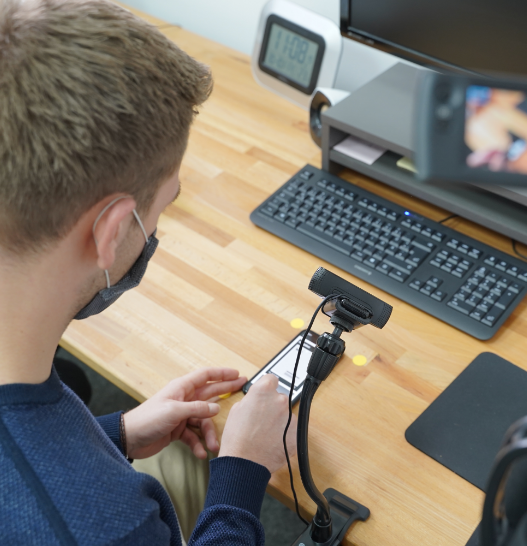A contextual inquiry is often the best choice for obtaining initial basic clues about the context of use. But what exactly does this method involve, how does it work, what are the best practices and what are the advantages and disadvantages? We would like to clarify all of this in this basic article.
We hope you enjoy reading it!
What exactly is a Contextual Inquiry?
Contextual inquiry is a mixture of field observation in the real context of use and simultaneous or subsequent questioning of the people observed. The idea of the method is to observe the user in their real environment when using the product and to ask them directly about their behavior.
The method has the following core elements:
- Observation in the natural environment: In contrast to laboratory experiments, contextual inquiry attempts to observe users in their natural environment. This can be at work, at home or in other places where users use the products or services.
- Active participation: The researcher actively participates in the user’s work process. This can mean asking questions, observing the user’s activities or even carrying out certain tasks together with the user.
- Open dialogs: During the contextual inquiry, open dialogs are conducted between the researcher and the user. The researcher inquires about the “why” and the “how” behind the user’s actions in order to gain deeper insights into their needs and decision-making processes.
- Continuous improvement: The method emphasizes continuous improvement through repeated observations and adjustments. After the observations, design changes can be made and re-observations can be carried out (also through other UX methods) to ensure that the adjustments better meet user requirements.
How does a contextual inquiry work?
In a contextual inquiry, a person is observed on site, similar to a field observation. In contrast, however, the person being observed is actively interviewed. The interview can be conducted in parallel with the observation or afterwards, whereby the most efficient method is a parallel approach. It should be noted that questions and interventions can have an influence on the behavior of the person being interviewed. If there is no time pressure, it is advisable to observe passively before entering into the interview.
The preparation for contextual inquiries is similar to that for field observations and interviews, whereby a list of questions is drawn up and completed live, based on the observation situation. The strength of this method lies in the fact that it can save an iteration loop by effectively combining information from observation and interviews. Contextual inquiry is particularly suitable at the start of a project in order to gather a lot of information quickly and cost-effectively.
The questions often start with specific details of the current action and only move on to general questions afterwards. You should therefore concentrate on comprehension questions about the execution during the observation and only record the overall context afterwards. This enables efficient implementation and detailed recording of actions.
What should you bear in mind during a contextual inquiry?
Here are a few of our best practices for conducting a contextual inquiry:
- Define clear research objectives: Define clear and specific research objectives to determine the focus of the contextual inquiry. Clarify which questions are to be answered and develop hypotheses to be tested.
- Choose representative participants: Select participants who are representative of the target group for the product or service. If necessary, also consider different user types in order to obtain a diverse perspective.
- Advance approval and transparency: Inform the participants in advance about the purpose of the method and get their consent to participate. Clarify that the aim is to understand their way of working and not to evaluate them.
- Observation with empathy: Observe the users with empathy and try to put yourself in their shoes. Make sure to capture non-verbal signals and emotions of the users to get a more comprehensive picture.
- Ask open questions: Ask open questions to understand users’ thoughts, motivations and considerations. Ask about the “why” behind certain actions to gain deeper insights.
- Active participation, if possible: Actively participate in user activities to better understand their perspective. This may mean performing certain tasks yourself to experience the experience first-hand.
- Notes in real time: Take continuous detailed notes during the session to accurately document the context and processes. Use audiovisual aids to better record certain aspects.
- Flexibility and customization: Be flexible and adapt your approach to unexpected situations or new findings. Remain open to unexpected discoveries and adapt your questions accordingly.
- Ethics and data protection: Respect the privacy of participants and act ethically. Ensure that you adhere to privacy policies and practices.
What are the advantages of the method?
- Deep insights: Collection of both objective and subjective information in one go
- Less recruiting effort: Simplified recruitment of participants compared to two separate appointments
- Real understanding in context: Contextual inquiry allows researchers to observe users in their real environment, providing an authentic understanding of their activities, challenges and needs. This context helps to identify real problems and opportunities for improvement.
- Early insights: The method allows developers and designers to gain insights into user needs early on in the development process. This helps to identify and solve problems before a product is finalized, which can ultimately save costs and time.
- Real-time interaction: Through direct observation, researchers can track users’ actual interactions with a product or service in real time. This enables a deeper understanding of usage and identifies potential optimization opportunities.
- Uncovering implicit knowledge: Users may have difficulty explicitly articulating their needs and preferences. By observing their actions in their natural environment, researchers can uncover tacit knowledge that may not be captured through interviews or surveys.
- Holistic understanding: Contextual inquiry makes it possible to understand the entire workflow and context of user activities. This is particularly important to ensure that a product or service can be seamlessly integrated into the way users work.
- Improving user-centricity: By focusing on user contexts and needs, contextual inquiry helps to better align products and services with user requirements, resulting in user-centric solutions.
What are the disadvantages of the method?
- High evaluation effort: As both observation and survey data are generated
- Access problems: Similar to field observations, access problems can also occur here, especially in private or B2B environments.
- Time consuming: The method can be time consuming, especially when conducted in users’ natural environments. Observing and understanding the contexts takes time, and participating in the users’ activities can take some time.
- Cost: Conducting a contextual inquiry can be costly, especially if it involves travel or equipment costs. This can lead to budget constraints, especially for smaller projects or organizations.
- Subjective interpretation: The interpretation of observations in a session can be subjective. Researchers may have different perspectives and there is a risk of bias or prejudice when analyzing the data collected.
- Limited generalizability: Due to the focus on specific user contexts, Contextual Inquiry can sometimes provide less generalizable results. The observations are strongly limited to the specific conditions and environments of the users.
- Possible influence on users: The presence of researchers during the implementation can influence the behavior of users. Users may behave more consciously or cautiously, which may lead to a bias in the observations.
- Difficulties with sensitive topics: In some cases, users might be reluctant to disclose private or sensitive information when researchers are present in their personal spaces. This can lead to limitations in the collection of comprehensive information.
These questions are answered by a Contextual Inquiry?
- Which features do my users really need?
- Why do users use my product differently than intended?
- What general usability problems does my product have?
- Does the user want to use my product?
- Who are the main users of my product and how do they differ?
- Where do problems (e.g. errors, waiting times, getting “lost”) occur when using my product?
- Does the design of my interface support users in their tasks?
Not the right method for your question?
We have compiled the most important methods for the most typical questions in our method assistant. Try out the method assistant and find exactly the right method for your question.
The decision matrix in our book on usability and user experience design also makes it easier to choose the right method. There you will also find a lot of background knowledge about the method itself and UX & UI in general.
Conclusion
The combination of interview and field observation saves a lot of time, as the cause of any ambiguities can be investigated directly.
On the other hand, the presence of the interviewer and the interruption caused by their questions naturally influence the user and the way they interact with the product.
Nevertheless, there may be use cases where contextual inquiry is preferable to “cleaner” methods, for example if the interviewer’s time is severely limited or the use of the product only takes up a very small proportion of the actual task.
Let us find out together whether a Contextual Inquiry is the right method for your problem and how cooperation works in detail. You can find our contact details here.



